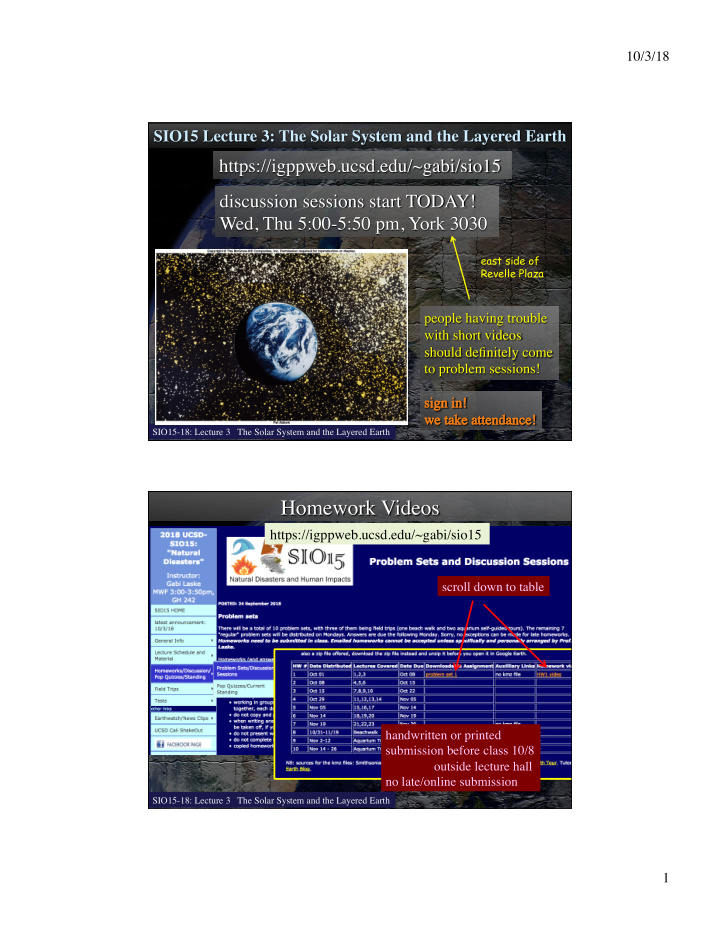



10/3/18 east side of Revelle Plaza SIO15-18: Lecture 3 The Solar System and the Layered Earth https://igppweb.ucsd.edu/~gabi/sio15 scroll down to table handwritten or printed submission before class 10/8 outside lecture hall no late/online submission SIO15-18: Lecture 3 The Solar System and the Layered Earth 1
10/3/18 https://igppweb.ucsd.edu/~gabi/sio15 scroll down farther SIO15-18: Lecture 3 The Solar System and the Layered Earth • conduction (energy passed between vibrating atoms; slow) • radiation (EM waves, no particle movement) • diffusion (migration of single particles; slow) • convection (mass transport; MOST EFFECTIVE) Fig 2.11 SIO15-18: Lecture 3 The Solar System and the Layered Earth Source: P. Abbott “Natural Disasters” 2
10/3/18 “hidden heat” Heat Capacity: ability to absorb heat while temperature rises only slowly Air: 0.00031 cal/cm 3 /ºC Quartz Sand: 0.31 Granite: 0.51 Water: 1.0 Aluminum: 0.215 Copper: 0.0924 Glass: 0.20 Human body: 0.83 Table 2.1 • water has high heat capacity! BTW these numbers refer to those • serves as moderator in the course book SIO15-18: Lecture 3 The Solar System and the Layered Earth any substance solid � ice liquid � water gas � water vapor/steam any phase change costs or releases energy Figure number in the book Fig. 2.12 SIO15-18: Lecture 3 The Solar System and the Layered Earth 3
10/3/18 evaporation: water vapor absorbs heat condensation: water vapor releases heat it takes 600 cal to evaporate 1g water Fig. 2.13 (at 0ºC) SIO15-18: Lecture 3 The Solar System and the Layered Earth Moon Formation Protoplanetary disk Source: wikipedia Fig 3.9 SIO15-18: Lecture 3 The Solar System and the Layered Earth 4
10/3/18 Fig 3.6 terrestrial planets, inner p.: Mercury, Venus, Earth, Mars (high density); rocky planets gas giants, outer planets: Jupiter, Saturn, Uranus, Neptune (low density) mass: sun has 99% of mass SIO15-18: Lecture 3 The Solar System and the Layered Earth Fig 3.5 Image: S. Marshak “Earth, Portrait of a Planet” momentum: p = m*v angular momentum: L = I* Ω planets have 99% of angular momentum comparable angular momentum -> inner planets orbit faster than outer planets (like skater tugging in arms) SIO15-18: Lecture 3 The Solar System and the Layered Earth 5
10/3/18 Watch short Video on tides (3a,b) SIO15-18: Lecture 3 The Solar System and the Layered Earth source: greatamericaneclipse.com Why do we not have eclipses every month? Earth’s orbit around Sun because Moon’s orbit around Earth does not lie in the ecliptic Moon’s orbit around Earth Sideways view SIO15-18: Lecture 3 The Solar System and the Layered Earth 6
10/3/18 Image: http://en.wikipedia.org • discovered in 1930 • Only 2/3 of Moon • Weird orbit • Smaller than Eris Makemake Xena (2005) (farther out than Pluto) Fig 3.12 DWARF PLANETS (2006) � own orbit around sun • Pluto (and Charon) � not at satellite • large trans-Neptunian objects � round • large asteroids (e.g. Ceres) � has NOT cleared its orbit SIO15-18: Lecture 3 The Solar System and the Layered Earth Fig 3.13 Bode’s Law see course book! Image: http://en.wikipedia.org • asteroid belt between Mars, Jupiter (tug of Jupiter prevented planet formation) • source of some impactors SIO15-18: Lecture 3 The Solar System and the Layered Earth 7
10/3/18 Fig 3.14 • rocky • low density IDA; 56km long + Dactyl most too small to be rounded 3 large > 500km diameter (Ceres, Pallas, Vesta) some have Earth crossing orbits: Apollos (Amors: Mars-crossing) SIO15-18: Lecture 3 The Solar System and the Layered Earth McNaught, 2007 Lovejoy, 2011 • icy (frozen volatiles) • rocky core (few km across) (Halley comet: 40km) • sunlight and solar wind -> comet ejects ionized gases and dust -> tail Hyakutake, 1996 Hale-Bopp, 1997 • Kuiper belt beyond Neptune: short-period comets • Oort cloud: long-period comets SIO15-18: Lecture 3 The Solar System and the Layered Earth 8
10/3/18 Fig 3.20 UV Hubble Image taken 21 July1994 source: NASA/wikipedia • first observation of an extraterrestrial impact • discovered 24 March 1993 at Palomar Obs. • probably captured by Jupiter 20-30 years earlier • fragmentation during July 1992 encounter • impact 16 – 22 July 1994 • scientists argued whether impact would be seen at all • captures by Jupiter not uncommon (19 July 2009) (“cosmic vacuum cleaner”) crater chain on Ganymede Hubble Image taken 17 May 1994 SIO15-18: Lecture 3 The Solar System and the Layered Earth 9/29/15 currently a matter of great debate � comets some have organic compounds � primordial Earth Europa Enceladus Mars?? water #1 condition for life to form Source: San Diego U-T SIO15-18: Lecture 3 The Solar System and the Layered Earth 9
10/3/18 Fig 3.19 • Meteoroid: object entering Earth’s atmosphere • Meteor: phenomenon seen in sky • Meteorite: piece(s) left on Earth’s surface after impact Willamette meteorite Meteors, shooting stars fragments of asteroids and comets that impacted on Earth � stony meteorite (less likely to survive) � iron meteorite (from core of differentiated asteroids) SIO15-18: Lecture 3 The Solar System and the Layered Earth mass exploded <10 km high in atmosphere? source: wikipedia felled trees no radioactivity remains from blast = 12-15 megatons (Bikini Atoll Bomb) Comet Encke??? light phenomenon 200 km away people knocked off their feet from shock wave pressure fluctuations in Britain volcanic area SIO15-18: Lecture 3 The Solar System and the Layered Earth 10
10/3/18 source: wikimedia very well documented by car dash-cams !! source: nationmultimedia SIO15-18: Lecture 3 The Solar System and the Layered Earth source: wordpress remains from 30-m mass exploded ~25km high in atmosphere? asteroid 2012 DA 14 16h later?? Chelyabinsk Zinc Factory source: wikipedia Chelyabinsk Drama Theater blast = <1 megaton (Tunguska 10x larger!) (20-30 Hiroshima bomb) light phenomenon 200 km away large number of small meteorites roof of zinc factory collapsed (from shock wave?) injuries due to blown-out windows (7,200 buildings) ground movement recorded 4000 km away SIO15-18: Lecture 3 The Solar System and the Layered Earth 11
Recommend
More recommend